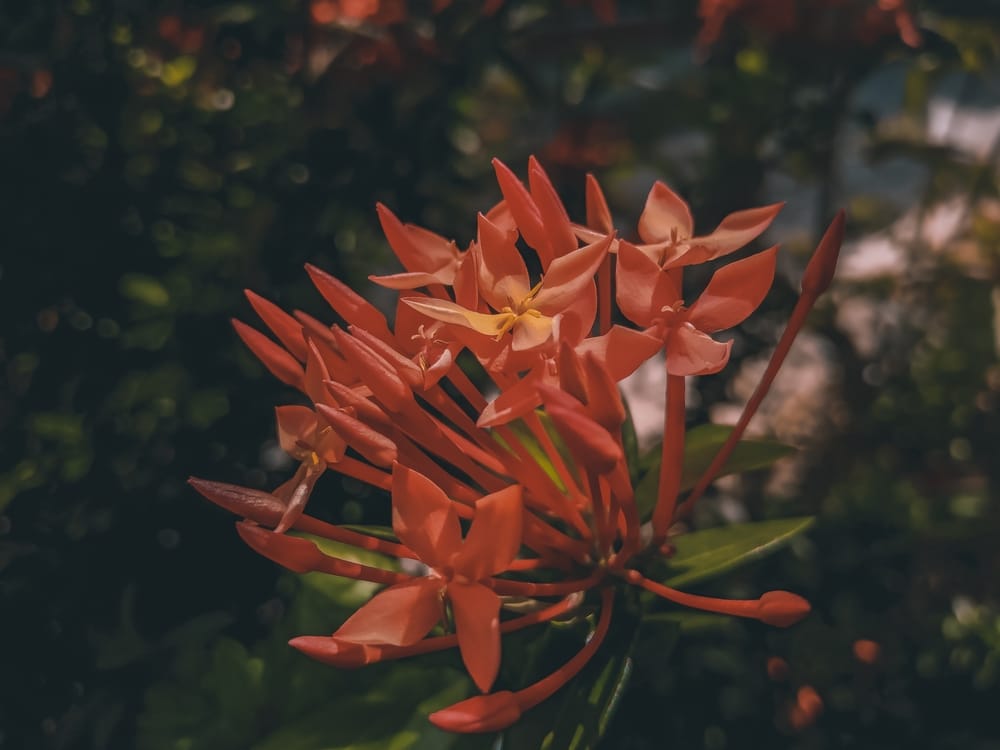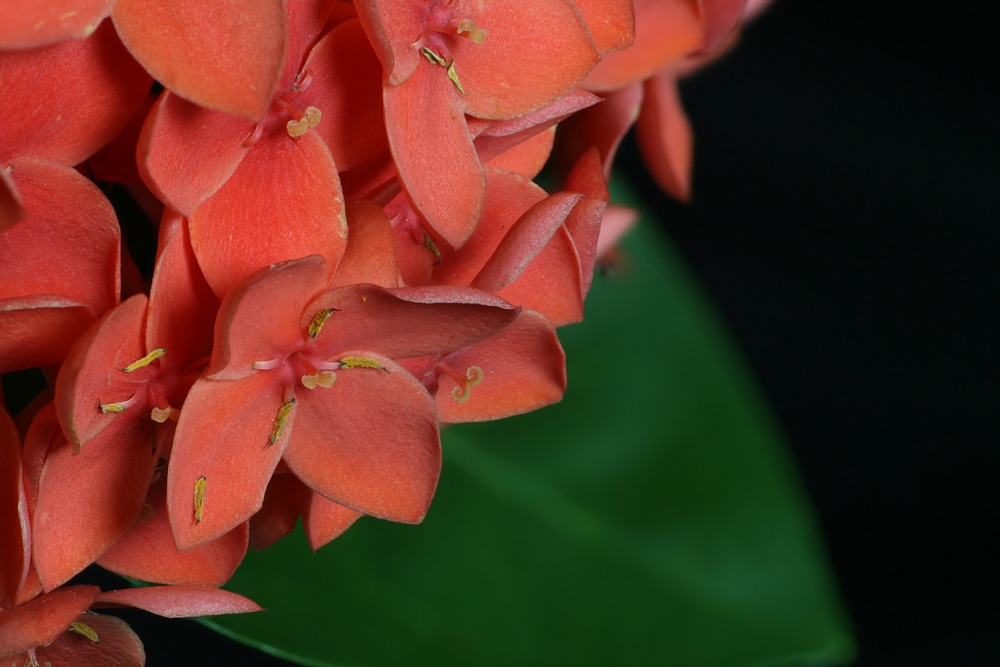The Maui Red Ixora is one of the most captivating houseplants, courtesy of being unusual. This plant has the following interesting facts about it:

| Botanical Name | Ixora coccinea |
| Common Name | Ixora, Maui Red, Ixora Maui Red, Indian Jasmine, Flame of The Woods |
| Plant Type | Perennial(Tropical or Subtropical Environments), Annual (Colder Climates) |
| Flower Color | Reddish Orange |
| Size When Mature | 4-6ft in height, 3-5ft in width |
| Bloom Time | Year-round |
| Sun Requirements | Full Sun |
| USDA Hardiness Zones | 9-11 |
| Soil PH Range | 5.5-6.5 |
| Soil Type | Acidic, well-draining |
| Water Needs | Medium |
| Native Area | Asia |
What you Need to Know About (The Plant)
The Ixora Maui Red is one of many Ixora varieties that belong to the Rubiaceae family. This small houseplant of shrub, if you would rather, is native to the tropical and subtropical regions of Asia.
Also referred to as the “Flame of The Woods”, this plant is commonly revered for its exceptionally bright and attractive reddish-orange blooms. The flowers are small, tubular, and about 4-6 inches across. These 4-petaled blooms take on a puffball appearance and fantastically emerge throughout the year.
The Maui red Ixora has oblong, evergreen leaves that have an opposite arrangement and measure about 3-4 inches in length. The leaves, when mature, have a medium green color, but they often take on a bronze color when new.
From time to time, this variety of Ixora will produce round berries that are reddish-to-blackish in color. The berries are not known to be poisonous to humans, cats, dogs, and a majority of other pets. In truth, Ixora berries have been established to have a medicinal value, but only when prepared in the right amounts.
How to Care for Ixora Maui Red
This plant is quite easy to grow and care for when planted in the ideal USDA hardiness zone. If, however, you want to grow it indoors, you will want to take extra care of it. Here’s everything you need to know about growing and caring for a thriving Ixora Maui red:
– Light
The Maui red Ixora grows best in locations that receive bright light. As such, you will want to make sure that your houseplant has access to about 8-10 hours of sunlight every day.
During the summer months, however, you will want to take your sun out of the path of the harsh sunlight rays to avoid burns or dried-out leaves.
While the Ixora Maui red prefers full sun for optimal growth, it should still be able to grow gloriously even in a partially-shaded place.
– Water Needs
This plant has average water needs, which means you will need to water it regularly. Make sure that the soil is always moist and avoid watering to a point where the soil becomes soggy.
For outdoor plants, one deep watering each week should be enough. Conversely, indoor plants will require more frequent watering, depending on the type of container that you are using.
When watering your Maui red Ixora, the goal is to make sure that the soil does not dry out completely. You may have to water during the winter, but not as frequently as you would during the spring and summer.
– Soil
The Maui red Ixora does best in humus-rich, well-drained soils. If you are growing your plant in a pot, you should use a potting mix that is designed for acid-loving plants. The ideal pH range of the soil that you will be growing your plants in should be between 5.5 and 6.5.
If the soil pH goes beyond 7.0, the leaves will have a dull color. As such, it’s recommended that you use a soil test kit to monitor the pH of your soil and take the necessary steps to make adjustments where needed.
– Humidity needs
Given that the Maui red Ixora is a tropical plant, it thrives best in humid conditions. If you live in an area with low humidity, you will need to take steps to increase the humidity around your plant.
One way to do this is by placing your plant on a pebble tray. You can also use a humidifier to raise the humidity in the room where your plant is located.
– Temperature Requirements
This plant is tropical, which means that it prefers warm temperatures. The ideal temperature range for the Maui red Ixora is between 65 and 75 degrees Fahrenheit. The ideal USDA hardiness zones that provide such conditions are USDA zones 9-11.
During the winter, you will want to make sure that the temperature does not drop below 60 degrees Fahrenheit as this can damage the plant. If, therefore, you live in an area with cold winters, it is best to grow your Maui red in a container so that you can overwinter it indoors.
– Fertilizer
The best fertilizer to use on an Ixora Maui red is a slow-release, balanced fertilizer that is formulated for acid-loving plants, in the spring. If using liquid fertilizer, you will want to, most of the time, feed your plant weekly during the growing season.
Whenever applying fertilizer, be sure to follow the instructions on the package for the best results.
– Common Diseases
Just like most other Izora varieties, the Maui red Ixora requires protection from aphids and scale. Should you ever notice any of these pests on your plant, you will want to act quickly and use neem oil or insecticidal soap to get rid of them.
You may also notice dark spots on the leaves of plants that are not getting enough iron and manganese. This issue is notoriously prevalent in acid-loving plants. The good news is that you can use a chelated micronutrient fertilizer to fix the problem.
Maui Red Ixora Propagation
The best way to propagate your Ixora Maui red is by taking cuttings in the spring.
Rooting cuttings from an Ixora plant is not the easiest plant growing task. In addition to trying the rooting process with several cuttings, you may have to apply a little bit of heat as well as use rooting hormone to increase the chances of success.
After you have applied the hormone, you will have to avoid pushing the cutting directly into the potting mix. Use a pen or another cutting that had a wider girth than that of the hormone-treated cutting to make a hole in the mix. Doing this will help to avoid rubbing off the hormone.
Once done planting the cutting, water the soil lightly and place a clear plastic bag over the pot to create a humid environment. You will want to check on the cuttings regularly to make sure that the soil is moist but not waterlogged.
As for the sunlight, your cuttings will need filtered light before the leaves start to form. Once the leaves have emerged, you can now remove the plastic bag and move the plant to an area that gets full sunlight.
Related Article: Maui Ixora Care

